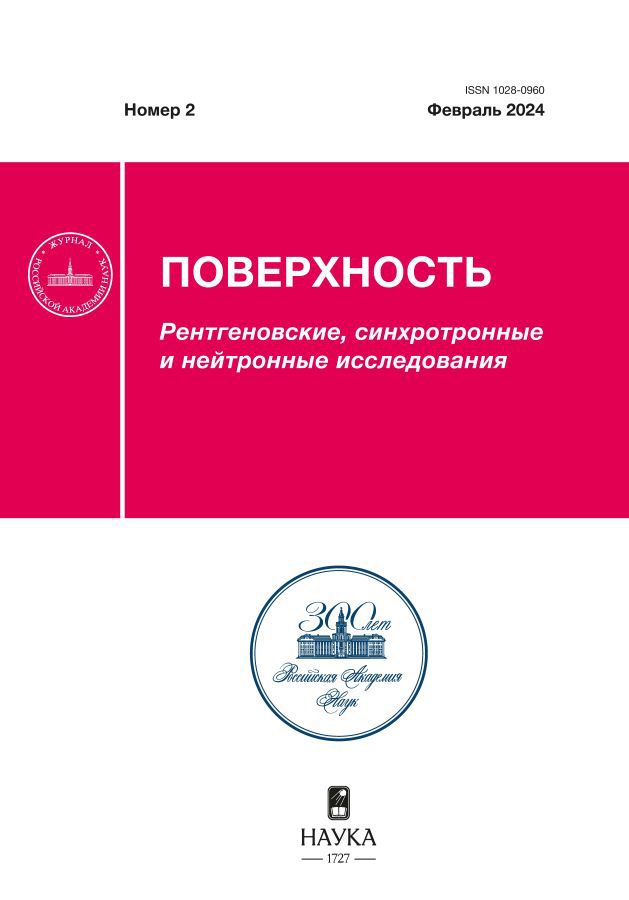Energy Barriers for the Spontaneous Magnetization Reversal of the Atomic Co Chains on Pt(664) Surface in the Model with Dzyaloshinskii–Moriya Interaction
- Авторлар: Kolesnikov S.V.1, Sapronova E.S.1
-
Мекемелер:
- Lomonosov Moscow State University, Faculty of Physics
- Шығарылым: № 2 (2024)
- Беттер: 36-43
- Бөлім: Articles
- URL: https://archivog.com/1028-0960/article/view/664775
- DOI: https://doi.org/10.31857/S1028096024020053
- EDN: https://elibrary.ru/BBXMXI
- ID: 664775
Дәйексөз келтіру
Аннотация
The analytical approach has been developed in the framework of the continuous XY-model. This approach allows calculating the spontaneous magnetization reversal time of finite-length atomic chains on the metallic surface. The interaction of the magnetic moments of atoms is described by the classical Hamiltonian, which includes the Heisenberg exchange interaction, the Dzyaloshinskii–Moriya interaction, and the magnetic anisotropy energy. Using the Co/Pt(664) system as an example, it has been shown that the proposed method is in a good agreement with the results of the numerical simulation in the limit of short and long atomic chains. And for atomic chains of intermediate length, it can be used to estimate an upper bound on the spontaneous magnetization reversal time. We obtained the dependences of the spontaneous magnetization reversal time of finite-length Co chains the value of the exchange integral, parameters of the magnetic anisotropy, and also on the value of the projection of the Dzyaloshinskii vector onto the axis perpendicular to the plane containing the magnetic moments of the atoms. It is shown that the proposed method has a wide range of applicability both in terms of temperature and the values of the physical parameters characterizing the magnetic properties of the atomic chains.
Авторлар туралы
S. Kolesnikov
Lomonosov Moscow State University, Faculty of Physics
Хат алмасуға жауапты Автор.
Email: kolesnikov_s_v_@mail.ru
Ресей, Moscow
E. Sapronova
Lomonosov Moscow State University, Faculty of Physics
Email: kolesnikov_s_v_@mail.ru
Ресей, Moscow
Әдебиет тізімі
- Zutic I., Fabian J., Das Sarma S. // Rev. Mod. Phys. 2004. V. 76. P. 323. https://www.doi.org/10.1103/RevModPhys.76.323
- Mermin N.D. Quantum Computer Science: An Introduction. Cambridge: Cambridge University Press, 2007.
- Bose S. // Phys. Rev. Lett. 2003. V. 91. P. 207901. https://www.doi.org/10.1103/PhysRevLett.91.207901
- Bose S. // Contemporary Phys. 2007. V. 48. P. 13. https://www.doi.org/10.1080/00107510701342313
- Verma H., Chotorlishvili L., Berakdar J., Mishra S.K. // Europhys. Lett. 2017. V. 119. P. 30001. https://www.doi.org/10.1209/0295-5075/119/30001
- Gambardella P., Dallmeyer A., Maiti K., Malagoli M.C., Eberhardt W., Kern K., Carbone C. // Nature. 2002. V. 416. P. 301. https://www.doi.org/10.1038/416301a
- Gambardella P., Rusponi S., Veronese M., Dhesi S.S., Grazioli C., Dallmeyer A., Cabria I., Zeller R., Dederichs P.H., Kern K., Carbone C., Brune H. // Science. 2003. V. 300. P. 1130. https://www.doi.org/10.1126/science.1082857
- Dzyaloshinsky I. // J. Phys. Chem. Solids. 1958. V. 4. P. 241. https://www.doi.org/10.1016/0022-3697 (58)90076-3
- Moriya T. // Phys. Rev. Lett. 1960. V. 4. P. 228. https://www.doi.org/10.1103/PhysRevLett.4.228
- Choi D.J., Lorente N., Wiebe J., von Bergmann K., Otte A.F., Heinrich A.J. // Rev. Mod. Phys. 2019. V. 91. P. 041001. https://www.doi.org/10.1103/RevModPhys.91.041001
- Ландау Л.Д, Лифшиц Е.М. Электродинамика сплошных сред. М.: Физматлит, 2005. 656 с.
- Nembach H.T., Shaw J.M., Weiler M., Jue E., Silva T.J. // Nature Phys. 2015. V. 11. P. 825. https://www.doi.org/10.1038/nphys3418
- Cho J., Kim N.-H., Lee S., Kim J.-S., Lavrijsen R., Solignac A., Yin Y., Han D.-S., van Hoof N.J.J., Swagten H.J.M., Koopmans B., You C.-Y. // Nature Comm. 2015. V. 6. P. 7635. https://www.doi.org/10.1038/ncomms8635
- Fert A., Reyren N., Cros V. // Nat. Rev. Mater. 2017. V. 2. P. 17031. https://www.doi.org/10.1038/natrevmats.2017.31
- Soumyanarayanan A., Reyren N., Fert A., Panagopoulos C. // Nature. 2016. V. 539. P. 509. https://www.doi.org/10.1038/nature19820
- Garst M., Waizner J., Grundler D. // J. Phys. D: Appl. Phys. 2017. V. 50. P. 293002. https://www.doi.org/10.1088/1361-6463/aa7573
- Mazzarello R., Tosatti E. // Phys. Rev. B. 2009. V. 79. P. 134402. https://www.doi.org/10.1103/PhysRevB.79.134402
- Menzel M., Mokrousov Y., Wieser R., Bickel J.E., Vedmedenko E., Blügel S., Heinze S., von Bergmann K., Kubetzka A., Wiesendanger R. // Phys. Rev. Lett. 2012. V. 108. P. 197204.
- Heide M., Bihlmayer G., Blügel S. // Phys. Rev. B. 2008. V. 78. P. 140403. https://www.doi.org/10.1103/PhysRevB.78.140403
- Schweflinghaus B., Zimmermann B., Heide M., Bihlmayer G., Blügel S. // Phys. Rev. B. 2016. V. 94. P. 024403. https://www.doi.org/10.1103/PhysRevB.94.024403
- Chotorlishvili L., Wang X., Dyrdal A., Guo G., Dugaev V.K., Barnás J., Berakdar J. // Phys. Rev. B. 2022. V. 106. P. 014417. https://www.doi.org/10.1103/PhysRevB.106.014417
- Kolesnikov S.V., Sapronova E.S. // IEEE Magn. Lett. 2022. V. 13. P. 2505905. https://www.doi.org/10.1109/LMAG.2022.3226656
- Bessarab P.F., Uzdin V.M., Jonsson H. // Computer Phys. Comm. 2015. V. 196. P. 335. https://www.doi.org/10.1016/j.cpc.2015.07.001
- Chudnovsky E.M., Gunther L. // Phys. Rev. Lett. 1988. V. 60. P. 661. https://www.doi.org/10.1103/PhysRevLett.60.661
- Smirnov A.S., Negulyaev N.N., Hergert W., Saletsky A.M., Stepanyuk V.S. // New J. Phys. 2009. V. 11. P. 063004. https://www.doi.org/10.1088/1367-2630/11/6/063004
- Popov A.P., Rettori A., Pini M.G. // Phys. Rev. B 90, 134418 https://www.doi.org/10.1103/PhysRevB.90.134418
- Колесников С.В., Сапронова Е.С. // ЖЭТФ. 2022. Т. 162. Вып. 5. С. 708.
- Колесников С.В., Колесникова И.Н. // ЖЭТФ. 2017. Т. 152. Вып. 4. С. 759.
Қосымша файлдар











